Finding the right power dialer for you is a difficult and lengthy process. So, wanted to do the hard work for you and compare two excellent options – CRMDialer and Salesforce. Let’s dig in and find out which of these two is the better option for sales teams that make a lot of calls.
Your CRM is the cornerstone of your entire sales process. Do it right and you’ll help your reps close new deals every day thanks to a hot supply of great leads. Choose the wrong CRM and your reps will end up doing data entry and updating lead records instead of making calls.
If you’re looking for a capable CRM application that is built for both small and enterprise businesses, CRMDialer is the right choice. Besides the power dialer, it also offers features such as integrated email and SMS, managing and uploading your leads, automated follow-ups, website visitors tracking and more.
At the heart of CRMDialer, there is a phone system that will revolutionize how your sales team works. You can set up call queues and enable local presence so that your leads know that you are calling them from a local number. Moreover, you can use call outcome tracking to take actions before even hanging up on a call, all in the purpose of making your sales team more efficient. For all of these reasons, CRMDialer is a worthy Salesforce competitor – let’s see how the two compare.

Dialer Features

At the very core of CRMDialer is the power dialer – the portion of the app that allows you to make outbound calls and take inbound calls from your leads.
As many of our customers have proven in their use of CRMDialer, you can increase the number of your outbound calls as much as three times by going through imported lead lists in the Power Dialer.
On top of making and taking calls, agents have another cool feature at their disposal – voicemail drops. They can record a sentence or two for leads that are not picking up and when they hear that they’re going to an answering machine, they can just hit one button and release a voicemail drop and leave the call. This small feature can save hours on calls every month.
The moment you get on a call with your leads, you can make a variety of different actions. First, you can make a note during the call or take a look at the notes you’ve made before, right as you’re on the call. If you want to schedule a meeting, you can create an event from the call and add it to your calendar. Depending on the outcome of the call, you can change the status of the lead to prospecting, for example.
If you want a bird’s eye view of your sales reps, you can eavesdrop on their calls as the space administrator. You can listen to their calls, whisper to them (without the other person hearing you) or use the option of barging in and taking over the call.
It’s useful to listen to old calls, so you can record your reps’ calls that they make in CRMDialer. Depending on the state that the lead is in, CRMDialer will either start recording automatically or give you the option of recording once you have the other party’s consent.
Moreover, you can use CRMDialer to receive inbound calls. When a call comes in, the app recognizes the number and ties it to the lead record in your CRM. Before you even answer the call, you’ll have all the data you need to close the deal. Finally, you can set up your own IVR and call trees to manage your inbound calls with ease.
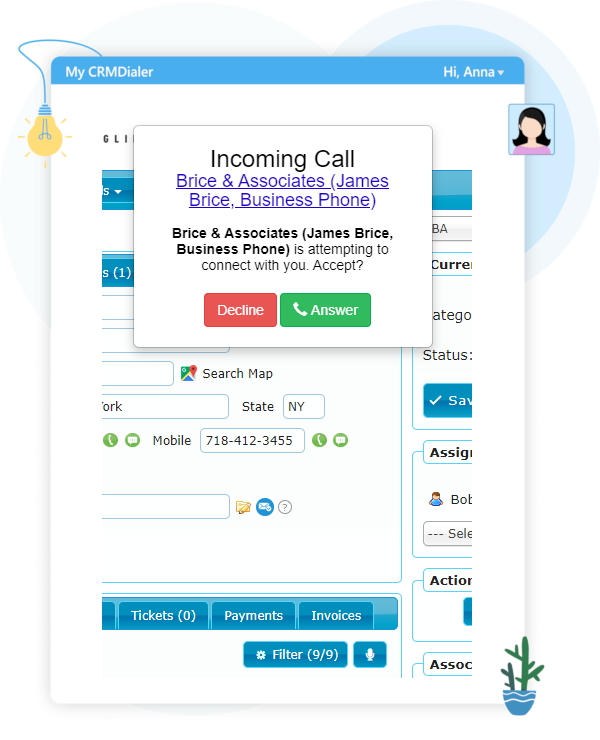
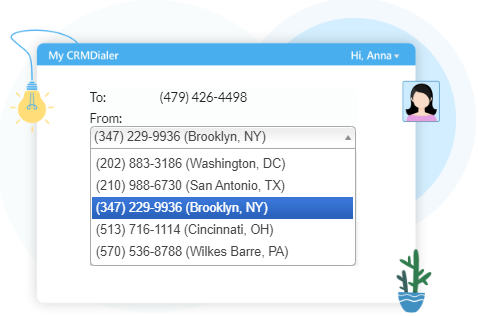
No matter which feature you choose from these, all of them come with detailed reporting. This way, you know exactly which agent talked to which lead and for how long. Not only that, but you can also see whether your reps are following up on their leads.
Local Presence is one of the top features in CRMDialer. When you’re on a call with a lead, CRMDialer will automatically change your caller ID so that it looks like a local number. Needless to say, this will drastically improve your pick-up rates.
Last but not least, there are call queues for inbound calls. Let’s say that you have a call and there’s no one available in your sales rep force to answer. Chances are, you’re going to lose the deal. However, you can set up call queues in CRMDialer so that the lead gets a recording until there’s an available agent to pick up the call.
As soon as there’s an available agent, they get the next inbound call directly from the queue. After all, no one wants to be put on hold!
Once the call is done, the job of a sales rep is not fully done as well. Using CRMDialer, your reps can create call outcomes with a single click, instead of taking manual notes. Not only does this save hours every month, but it helps keep your CRM records spotless and it lets you see how good of a day or month your reps are having.
On the other hand, there is the dialer in Salesforce, called Lightning Dialer. The most important thing you need to know is that just to use it, you’re going to need to add $25 per month per user on top of an existing Salesforce package. Do you want to receive inbound calls? That’s another $5 per user per month. Finally, just buying these two doesn’t warrant a thing because you need to load up on minutes. More specifically, each block of 1,000 minutes costs you $15.
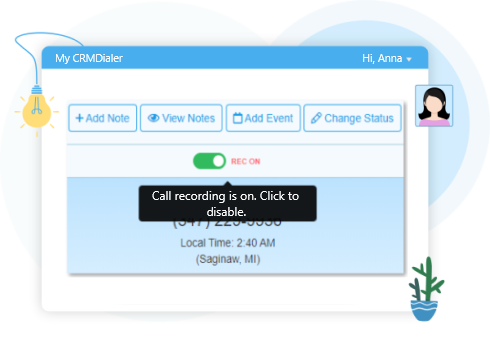
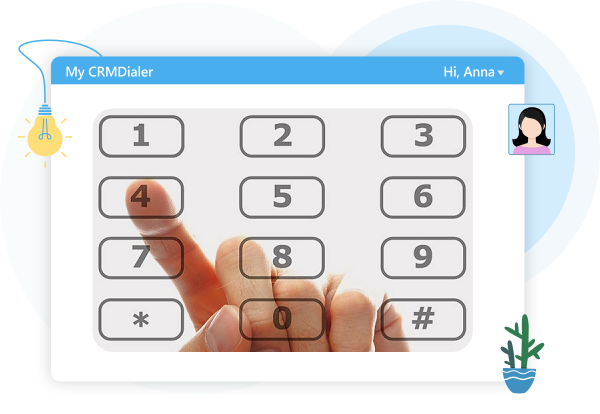
As you can see, just being able to call your leads from the Lightning Dialer is going to cost a pretty penny.
As for the dialer itself, it is pretty basic in its functions. You can monitor and record calls and make notes during calls, which get added to your CRM records. For inbound calls, you can leave pre-recorded messages, forward incoming messages and even enable local presence.
In general, the dialing feature in Salesforce is definitely lackluster, especially given the price added to the basic CRM package.
SMS Features
The ability to send text messages through the CRM is one of the features in CRMDialer that our users love the most. Just go to your dashboard and you can start sending text messages within a few clicks. Once an SMS goes out to a certain lead, you can see it in their record in the CRM.
To combine two cool features at once, you can use local presence with SMS so that your phone number will change dynamically based on who the recipient is. Of course, you can also receive text messages and CRMDialer will refresh your inbox in 15-second intervals. In the unlimited Pro plan, you’ll get 10,000 messages monthly.
Similar to emails (we’ll get to that in a minute), you can create SMS templates that look like this:

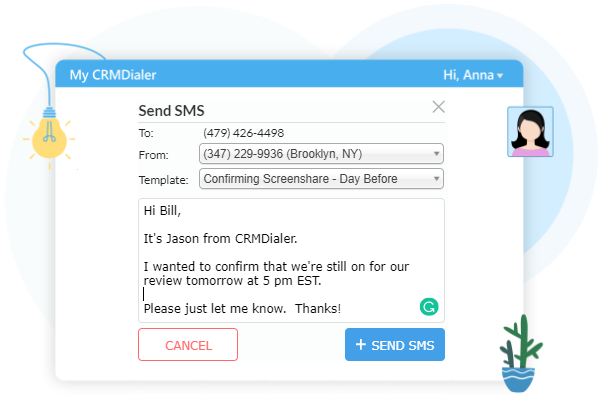
As you can see in this template, you can send mass text messages to a large bulk of contacts. All you need is the information you already have in CRMDialer. You can create an unlimited number of templates so you can test which one works the best with your target audience.
On the other hand, there is a major disappointment – Salesforce doesn’t let you send SMS messages at all. In fact, the only way to send messages through the platform is by connecting Salesforce through different integrations. However, as many different sources state, these integrations can be painful to use if you send a lot of messages internationally.
Email Features
Emails are the bread and butter of every good sales process. Luckily for you, CRMDialer is chock-full of email templates that you can use in different situations, from cold outreach to follow-ups. You can edit the templates to your liking so that you can come up with your own unique sequence.
Besides the templates in the app, you can also use the CRMDialer Google Chrome plugin, which is completely free to download. The plugin activates itself in Gmail and it helps you create emails with ease by automatically plugging in templates from CRMDialer
Not only that, but you can handwrite your emails more quickly too. The Chrome plugin comes with an in-built text-to-speech recognition feature. Just click a button and dictate your emails so that you spend less time writing and more time selling.
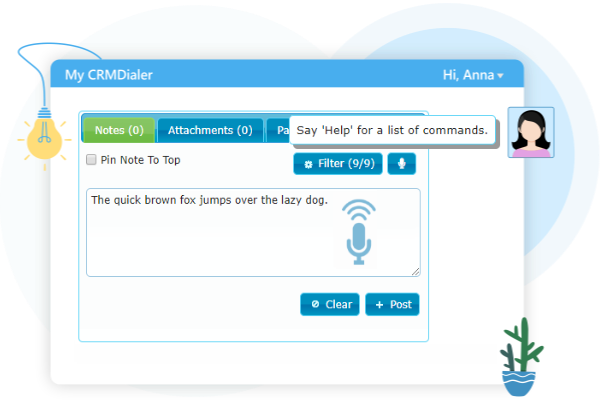
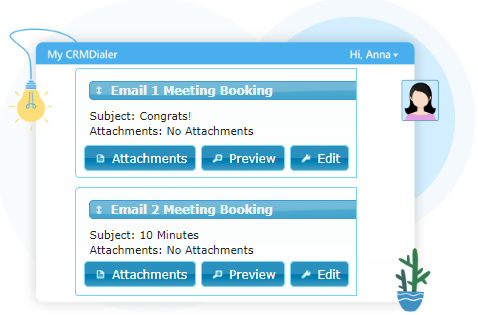
Of course, there is a wide variety of templates that you can use and alter according to your needs. The templates pull the data from your CRM, so you can get really creative and fully customize your emails with just a few clicks.
When the template is done and you’re ready to send out some emails, all of the blank fields will get populated with data from your CRM.
And once you’re ready to hit send, there are some additional cool features. For example, you can set your emails to be tracked upon opening, which can be a massive game-changer for your sales team.
Last but absolutely not least, CRMDialer ensures that you’re not messaging bogus emails. There is free email verification for up to 1,000 email contacts per month. This means that your recipients are verified so that your emails don’t end up going to non-existent addresses.
On the other hand, Salesforce also has the ability to send emails to your leads. There are a dozen templates to choose from and you can personalize each one with a few clicks and adjust them to different campaigns. There is nothing bad to say about this feature, except that the number of templates and campaigns could be bigger to suit a broader range of businesses.
In terms of deliverability, there are different reports from Salesforce users. However, there are some complaints of emails going to spam, which is worth keeping in mind if you rely heavily on email as part of your sales tool arsenal.

Visitor Tracking
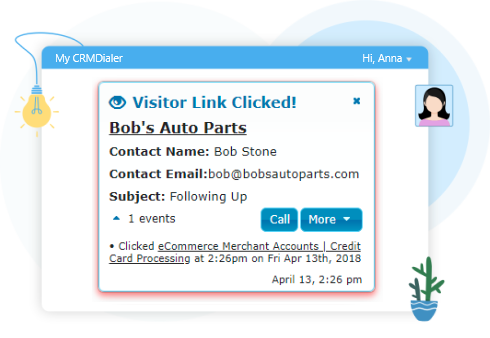
Website visitor tracking is an option in CRMDialer which you have to see in action. On top of tracking emails, calls and messages, you can track how visitors behave on your website. Not only historically, but also in real time. So, if someone has visited your website before and you planted a cookie on their device, you can track what they are doing exactly when they are on your website, as well as see what they’ve done before the call. You can pretty much know if a lead is ready to close just based on this information.
You can also track your leads through the CRMDialer Chrome plugin, if you don’t want to fire up the app every time you want to track user behavior.
Like CRMDialer, Salesforce has its own version of visitor tracking. However, it’s fairly limited in comparison. You can track only those actions directly related to the emails you send. In other words, you’ll be able to see if someone opened your email, how long they’ve read the email for, whether they clicked a link from or watched a video. Essentially, the visitor tracking feature in CRMDialer is much more powerful.
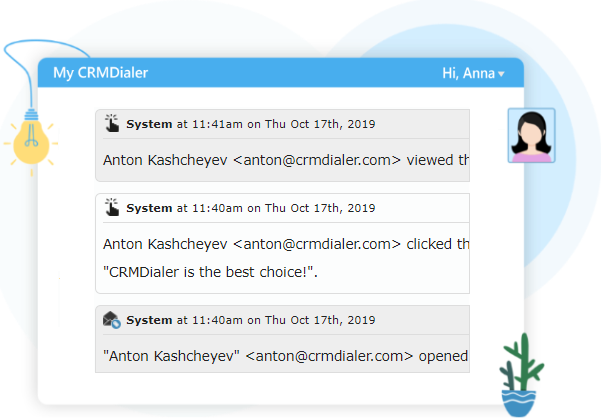
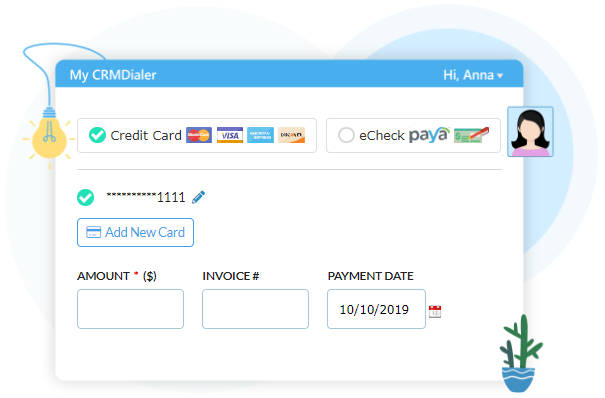
CRMDialer Extra: Invoices and Payments
On top of all other handy features, you can also issue invoices and collect customer payments in CRMDialer. You can easily generate invoices for all of your deals, for one-time and recurring payments. Not only can you create invoices, you can also collect payments through different processors such as credit cards and ACH.
CRMDialer Extra: E-Signature
All done with the details? You’re ready to close. Using CRMDialer, you can create, send out and pre-fill contracts. Once the contract is sent out, you can see when the lead opens it and signs it. What’s more, once they’ve signed, the contract is automatically uploaded to the platform.
Salesforce does not have any sort of built-in e-signature features, which means that you will have to look elsewhere, which means more integrations and more money spent. CRMDialer strides far and wide ahead in this department.
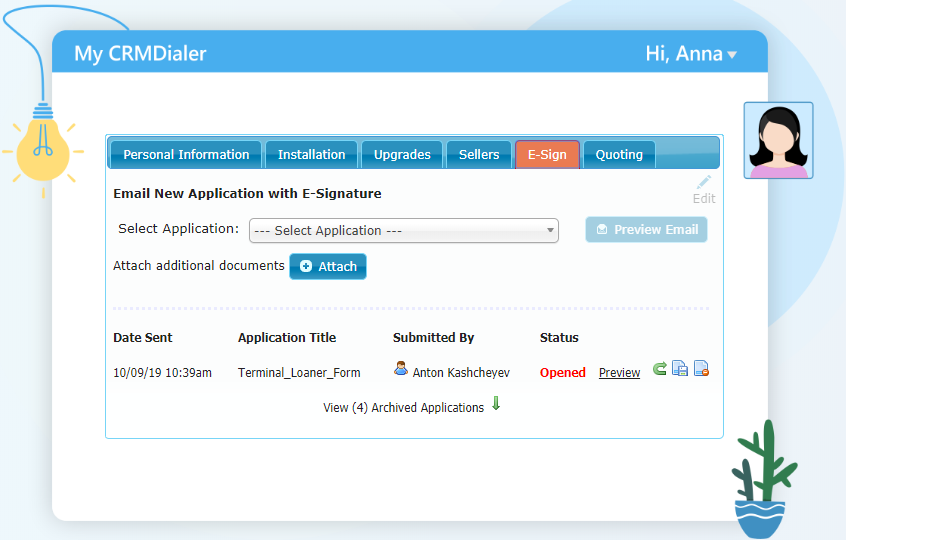
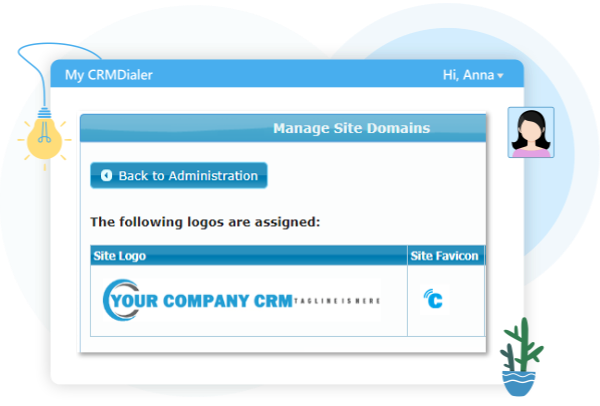
CRMDialer Extra: White-Label Customization
It’s completely normal to want to adjust your processes if you’re growing your business. That’s why CRMDialer is completely white-labeled so that you can adjust it for your needs and desires. Everything can be changed, starting from permissions all the way to branding. If you’re having any problems figuring out how to use white-labeling, our support team is there to help out.
Salesforce meanwhile has very few customization options, which means that you will be stuck with a rigid CRM, and will have to build your process around it.
Overall, CRMDialer comes out head over heels in this department, so that you can ensure that your process can keep growing, and you won’t be shackled down from making any changes.
The Pricing
CRMDialer pricing
Currently, you can choose two plans in CRMDialer. Essential will cost you $149 per user per month, which gets you 5,000 voice minutes and 500 SMS credits, per user per month. These are all unlimited: sales leads, emails, events, documents, and visitor tracking.
The more expensive plan is named Growth. At $1,199, it gives you lots of options. First of all, you get unlimited users. Second, there is 40,000 voice minutes and 1,000 validated emails monthly. To top it off, there are 5 e-signatures available per month as well. For large teams, this plan makes the most sense financially because of how much you can get for a fixed sum.
CRMDialer’s pricing is ideal for companies looking for a dedicated CRM + power dialer to cover all of their bases.
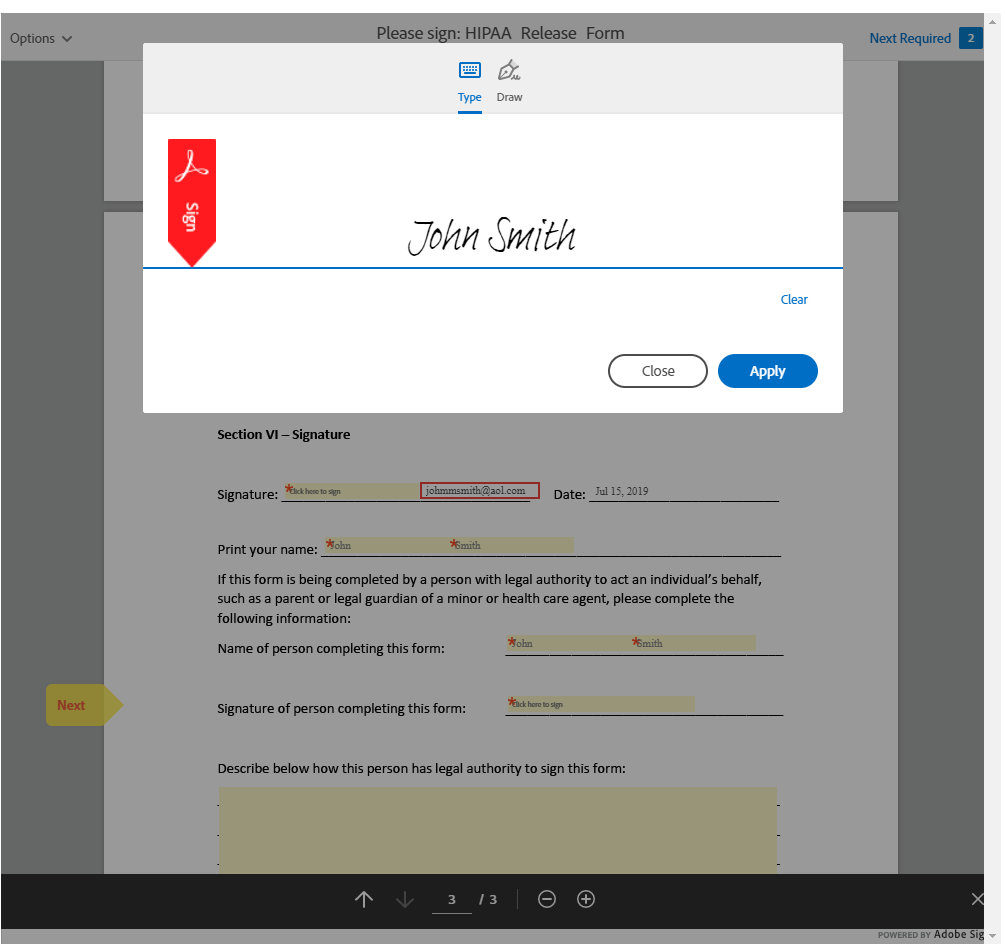
Salesforce Pricing
When you first land on Salesforce’s pricing page, you may think that the tools is fairly cheap compared to what you get for the money. The problem is, there is a whole host of different packages and upgrades and the base price of $25 per user per month is just for a single set of tools. If you want the complete CRM package, it will cost you $100 per user per month, but there is just one problem – you have to commit to an annual plan right off the bat. You’re essentially locked into paying $1,200 per user, which can get pretty expensive if you have a larger sales team.
It’s difficult to give a direct comparison between the two tools and their prices, because there are different addons and packages in Salesforce, ranging from $20 to $325 per user per month. If we take their most popular Enterprise CRM as a standard for comparison at $175 per user per month, Salesforce is definitely the pricier option of the two.
Overall, Salesforce is extremely capable but the pricing is anything but fair, especially given the fact that your entire organization has to commit to an annual plan immediately.
The Pricing Winner
Overall, the biggest difference between the two products is the cost. Salesforce costs almost double the amount of CRMDialer and in return, there are unlimited sales calls. However, CRMDialer makes up for this fact by giving extra features such as visitor tracking, invoicing, e-signatures, payments and much more.
In the end, everything depends on your use case. However, it is unmistakably clear that CRMDialer’s pricing package is simpler, easier to understand packs more value at a smaller price point.
Finally, what really sells CRMDialer is the Growth plan. It is more expensive at $1,199, but it offers a lot of value for larger sales teams that need a dedicated dialer and functional CRM.
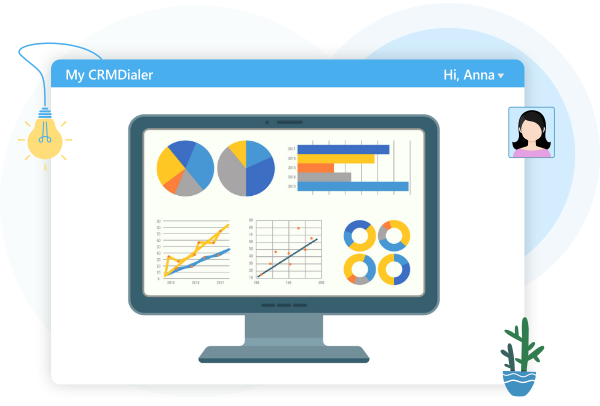
Conclusion
CRMDialer and Salesforce are two very capable sales tools that focus on dialing as their main aspect. There are lots of overlaps in their use case, target market, their features, and overall performance. However, there are certain differences that make either of them a better fit for some type of customer.
Salesforce offers unlimited dialing and focuses primarily on calls as the main sales tool. Dialing is Salesforce’s strongest aspect and the rest of its features are lacking compared to major CRM competitors such as Hubspot or Salesforce. If you are looking for an app that excels at dialing and you already have a strong CRM as the basis for your sales, Salesforce is a good choice.
On the other hand, CRMDialer provides a competitive package with an excellent power dialer. CRMDialer app offers a capable CRM with a range of extras that you can only get in top-of-the-line CRMs such as Hubspot. Overall, CRMDialerf packs more punch for a significantly lower price point which makes for a better choice for anyone looking for an all-around performer CRM and power dialer in one. Whereas Salesforce feels more like a power dialer to add to your existing CRM app, CRMDialer feels like a complete app to empower your sales team.